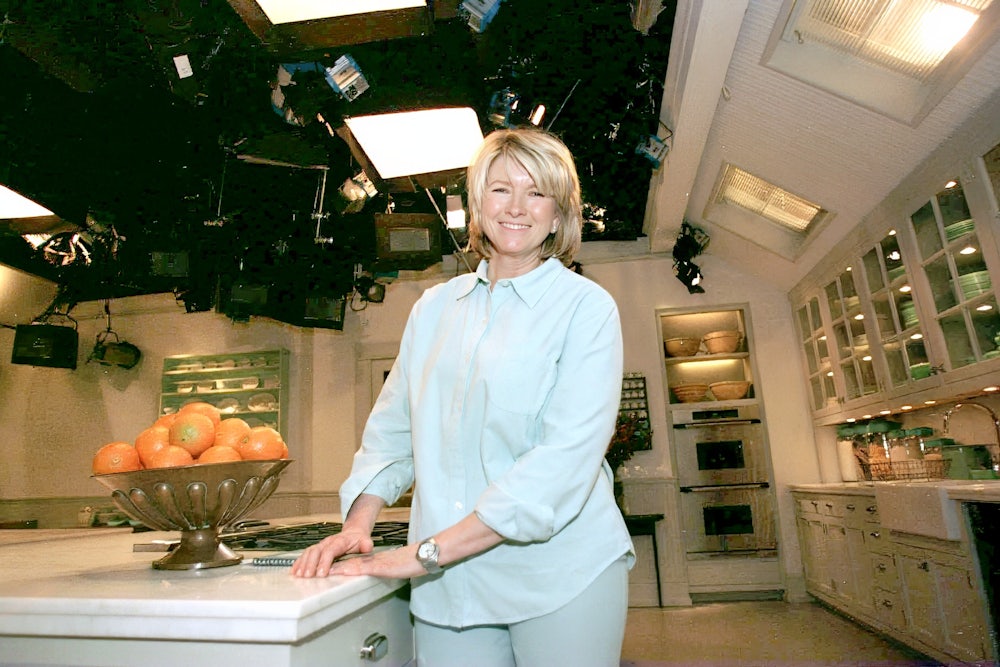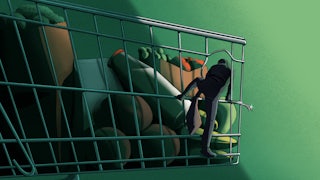During its early years, the magazine enjoyed swimming in the pool of popular culture, but the magazine also went decades where it barely engaged with television or other artifacts of the masses. That changed in the eighties and nineties. Editor Andrew Sullivan was a famous fan of The Simpsons and the Weather Channel, the sort of obsessions that infiltrated the magazine. And Leon Wieseltier, an unmistakable highbrow, had no compunction about assigning pieces about the lowest subjects. The trick was that these pieces had to employ the very same rigor the magazine would apply to French symbolist poetry.
—Franklin Foer, former TNR editor, Insurrections of the Mind: 100 Years of Politics and Culture in America
Every age gets the household goddess it deserves. The ‘60s had Julia Child, the sophisticated French chef who proved as permissive as Dr. Spock. She may have proselytized for a refined foreign cuisine from her perch at a Boston PBS station, but she was always an anti-snob, vowing to “take a lot of the la dee dah out of French cooking.” With her madras shirts and her penumbra of curls, her 6’2” frame and her whinny of a voice, she exuded an air of Cambridge eccentricity—faintly bohemian and a little tatty, like a yellowing travel poster.
She was messy and forgiving. When Julia dropped an egg or collapsed a souffle, she shrugged and laughed. “You are alone in the kitchen, nobody can see you, and cooking is meant to be fun,” she reminded her viewers. She wielded lethal-looking kitchen knives with campy abandon, dipped her fingers into crème anglaise and wiped her chocolate-smeared hands on an apron tied carelessly at her waist. For Child was also something of a sensualist, a celebrant of appetite as much as a pedant of cooking.
In the ‘90s, and probably well into the next century, we have Martha Stewart, corporate overachiever turned domestic superachiever, Mildred Pierce in earth-toned Armani. Martha is the anti-Julia. Consider the extent of their respective powers. At the height of her success, Child could boast a clutch of bestselling cookbooks and a gemütlich TV show shot on a single set. At what may or may not be the height of her success, here’s what Stewart can claim: a five-year-old magazine, Martha Stewart Living, with a circulation that has leapt to 1.5 million; a popular cable TV show, also called “Martha Stewart Living” and filmed at her luscious Connecticut and East Hampton estates; a dozen wildly successful gardening, cooking and lifestyle books; a mail-order business, Martha-by-Mail; a nationally syndicated newspaper column, “Ask Martha”; a regular Wednesday slot on the “Today” show; a line of $110-a-gallon paints in colors inspired by the eggs her Araucana hens lay; plans to invade cyberspace—in short, an empire.
Julia limited herself to cooking lessons, with the quiet implication that cooking was a kind of synecdoche for the rest of bourgeois existence; but Martha’s parish is vaster, her field is all of life. Her expertise, as she recently explained to Mediaweek magazine, covers, quite simply, “Beautiful soups and how to make them, beautiful houses and how to build them, beautiful children and how to raise them.” (From soups to little nuts.) She presides, in fact, over a phenomenon that, in other realms, is quite familiar in American society and culture: a cult, devoted to her name and image.
In the distance between these two cynosures of domestic life lies a question: What does the cult of Martha mean? Or, to put it another way, what have we done, exactly, to deserve her?
If you have read the paper or turned on the television in the last year or so, you have probably caught a glimpse of the waspy good looks, the affectless demeanor, the nacreous perfection of her world. You may even know the outlines of her story. Middle-class girl from a Polish-American family in Nutley, New Jersey, works her way through Barnard in the early ‘60s, modeling on the side. She becomes a stockbroker, a self-described workaholic and insomniac who by the ‘70s is making six figures on Wall Street, and who then boldly trades it all in ... for life as a workaholic, insomniac evangelist for domesticity whose business now generates some $200 million in profits a year. (She herself, according to the Wall Street Journal, makes a salary of $400,000 a year from Time Inc., which generously supplements this figure with a $40,000 a year clothing allowance and other candies.) You may even have admired her magazine, with its art-book production values and spare design, every kitchen utensil photographed like an Imogen Cunningham nude, every plum or pepper rendered with the loving detail of an eighteenth-century botanical drawing, every page a gentle exhalation of High Class.
What you may not quite realize, if you have not delved deeper into Stewart’s oeuvre, is the ambition of her design for living—the absurd, self-parodic dream of it. To read Martha Stewart is to know that there is no corner of your domestic life that cannot be beautified or improved under careful tutelage, none that should not be colonized by the rhetoric and the discipline of quality control.
Work full time though you may, care for your family though you must, convenience should never be your watchword in what Stewart likes to call, in her own twee coinage, “homekeeping.” Convenience is the enemy of excellence. “We do not pretend that these are ‘convenience’ foods,” she writes loftily of the bread and preserves recipes in a 1991 issue of the magazine. “Some take days to make. But they are recipes that will produce the very best results, and we know that is what you want.” Martha is a kitchen-sink idealist. She scorns utility in the name of beauty. But her idealism, of course, extends no further than surface appearances, which makes it a very particular form of idealism indeed.
To spend any length of time in Marthaland is to realize that it is not enough to serve your guests homemade pumpkin soup as a first course. You must present it in hollowed-out, hand-gilded pumpkins as well. It will not do to serve an Easter ham unless you have baked it in a roasting pan lined with, of all things, “tender, young, organically-grown grass that has not yet been cut.” And, when serving a “casual” lobster and corn dinner al fresco, you really ought to fashion dozens of cunning little bamboo brushes tied with raffia and adorned with a chive so that each of your guests may butter their corn with something pretty.
To be a Martha fan (or more precisely, a Martha adept) is to understand that a terracotta pot is just a terracotta pot until you have “aged” it, painstakingly rubbing yogurt into its dampened sides, then smearing it with plant food or “something you found in the woods” and patiently standing by while the mold sprouts. It is to think that maybe you could do this kind of thing, anyway—start a garden, say, in your scruffy backyard—and then to be brought up short by Martha’s enumeration, in Martha Stewart’s Gardening, of forty-nine “essential” gardening tools.
These range from a “polesaw” to a “corn fiber broom” to three different kinds of pruning shears, one of which—the “loppers”—Martha says she has in three different sizes. You have, perhaps, a trowel. But then Martha’s garden is a daunting thing to contemplate, what with its topiary mazes and state-of-the-art chicken coop; its “antique” flowers and geometric herb garden. It’s half USDA station, half Sissinghurst. And you cannot imagine making anything remotely like it at your own house, not without legions of artisans and laborers and graduate students in landscape design, and a pot of money that perhaps you’ll unearth when you dig up the yard.
In The Culture of Narcissism, Christopher Lasch describes the ways in which pleasure, in our age, has taken on “the qualities of work,” allowing our leisuretime activities to be measured by the same standards of accomplishment that rule the workplace. It is a phenomenon that he memorably characterizes as “the invasion of play by the rhetoric of achievement.” For Lasch, writing in the early ‘70s, the proliferation of sex-advice manuals offered a particularly poignant example.
Today, though, you might just as easily point to the hundreds of products and texts, from unctuous homefurnishings catalogs to upscale “shelter” magazines to self-help books like Meditations for Women Who Do Too Much, that tell us exactly how to “nest” and “cocoon” and “nurture,” how to “center” and “retreat,” and how to measure our success at these eminently private pursuits. Just as late-nineteenth-century marketers and experts promised to bring Americans back in touch with the nature from which modern industrial life had alienated them, so today’s “shelter” experts—the word is revealingly primal—promise to reconnect us with a similarly mystified home. The bourgeois home as lost paradise, retrievable through careful instruction.
Martha Stewart is the apotheosis of this particular cult of expertise, and its most resourceful entrepreneur. She imagines projects of which we would never have thought—gathering dewy grass for our Easter ham, say—and makes us feel the pressing need for training in them. And she exploits, brilliantly, a certain estrangement from home that many working women feel these days. For women who are working longer and longer hours at more and more demanding jobs, it’s easy to think of home as the place where chaos reigns and their own competence is called into doubt; easy to regard the office, by comparison, as the bulwark of order.
It is a reversal, of course, of the hoary concept of home as a refuge from the tempests of the marketplace. But these days, as the female executives in a recent study attested, the priority they most often let slide is housekeeping; they’ll abide disorder at home that they wouldn’t or couldn’t abide at the office. No working couple’s home is the oasis of tranquility and Italian marble countertops that Marthaism seems to promise. But could it be? Should it be? Stewart plucks expertly at that chord of doubt.
In an era when it is not at all uncommon to be cut off from the traditional sources of motherwit and household lore—when many of us live far from the families into which we were born and have started our own families too late to benefit from the guidance of living parents or grandparents—domestic pedants like Martha Stewart rightly sense a big vacuum to fill. Stewart’s books are saturated with nostalgia for lost tradition and old moldings, for her childhood in Nutley and for her mother’s homemade preserves. In the magazine, her “Remembering” column pines moralistically for a simpler era, when beach vacations meant no television or video games, just digging for clams and napping in hammocks. Yet Stewart’s message is that such simplicity can only be achieved now through strenuous effort and a flood of advice. We might be able to put on a picnic or a dinner party without her help, she seems to tell us, but we wouldn’t do it properly, beautifully, in the spirit of excellence that we expect of ourselves at work.
It may be that Stewart’s special appeal is to women who wouldn’t want to take their mother’s word anyway, to baby-boomer daughters who figure that their sensibilities are just too different from their stay-at-home moms’, who can’t throw themselves into housekeeping without thinking of their kitchen as a catering business and their backyards as a garden show.
In fact, relatively few of Martha’s fans are housewives—72 percent of the subscribers to Martha Stewart Living are employed outside the home as managers or professionals—and many of them profess to admire her precisely because she isn’t one, either. As one such Martha acolyte, an account executive at a Christian radio station, effused on the Internet: “[Stewart] is my favorite independent woman and what an entrepreneur! She’s got her own television show, magazine, books and even her own brand of latex paint....Martha is a feisty woman who settles for nothing less than perfection.”
For women such as these, the didactic faux-maternalism of Martha Stewart seems the perfect answer. She may dispense the kind of homekeeping advice that a mother would, but she does so in tones too chill and exacting to sound “maternal,” singling out, for example, those “who will always be too lazy” to do her projects. She makes housekeeping safe for the professional woman by professionalizing housekeeping. And you never forget that Stewart is herself a mogul, even when she’s baking rhubarb crisp and telling you, in her Shakeresque mantra, that “It’s a Good Thing.”
It is tempting to see the Martha cult purely as a symptom of anti-feminist backlash. Though she may not directly admonish women to abandon careers for hearth and home, Stewart certainly exalts a way of life that puts hearth and home at its center, one that would be virtually impossible to achieve without somebody’s full-time devotion. (Camille Paglia has praised her as “someone who has done a tremendous service for ordinary women—women who identify with the roles of wife, mother, and homemaker.”) Besides, in those alarming moments when Stewart slips into the social critic’s mode, she can sound a wee bit like Phyllis Schlafly—less punitive and more patrician, maybe, but just as smug about the moral uplift of a well-ordered home.
Her philosophy of cultivating your own walled garden while the world outside is condemned to squalor bears the hallmarks of Reagan’s America—it would not be overreading to call it a variety of conservatism. “Amid the horrors of genocidal war in Bosnia and Rwanda, the AIDS epidemic and increasing crime in many cities,” Stewart writes in a recent column, “there are those of us who desire positive reinforcement of some very basic tenets of good living.” And those would be? “Good food, gardening, crafts, entertaining and home improvement.” (Hollow out the pumpkins, they’re starving in Rwanda.)
Yet it would, in the end, be too simplistic to regard her as a tool of the feminine mystique, or as some sort of spokesmodel for full-time mommies. For one thing, there is nothing especially June Cleaverish, or even motherly, about Stewart. She has taken a drubbing, in fact, for looking more convincing as a businesswoman than a dispenser of milk and cookies. (Remember the apocryphal tale that had Martha flattening a crate of baby chicks while backing out of a driveway in her Mercedes?) Her habitual prickliness and Scotchguard perfectionism are more like the badges of the striving good girl, still cut to the quick by her classmates’ razzing when she asked for extra homework.
Despite the ritual obeisance that Martha pays to Family, moreover, she is not remotely interested in the messy contingencies of family life. In the enchanted world of Turkey Hill, there are no husbands (Stewart was divorced from hers in 1990), only loyal craftsmen, who clip hedges and force dogwood with self-effacing dedication. Children she makes use of as accessories, much like Parisian women deploy little dogs. The books and especially the magazine are often graced with photographic spreads of parties and teas where children pale as waxen angels somberly disport themselves, their fair hair shaped into tasteful blunt cuts, their slight figures clad in storybook velvet or lace.
“If I had to choose one essential element for the success of an Easter brunch,” she writes rather menacingly in her 1994 Menus for Entertaining, “it would be children.” The homemade Halloween costumes modeled by wee lads and lasses in an October 1991 issue of Martha Stewart Living do look gorgeous—the Caravaggio colors, the themes drawn from nature. But it’s kind of hard to imagine a five-year-old boy happily agreeing to go as an acorn this year, instead of say, Batman. And why should he? In Marthaland, his boyhood would almost certainly be overridden in the name of taste.
If Stewart is a throwback, it’s not so much to the 1950s as to the 1850s, when the doctrine of separate spheres did allow married or widowed women of the upper classes a kind of power—unchallenged dominion over the day-to-day functioning of the home and its servants, in exchange for ceding the public realm to men. At Turkey Hill, Stewart is the undisputed chatelaine, micromanaging her estate in splendid isolation. (This hermetic pastoral is slightly marred, of course, by the presence of cameras.) Here the domestic arts have become ends in themselves, unmoored from family values and indeed from family.
Stewart’s peculiar brand of didacticism has another nineteenth-century precedent—in the domestic science or home economics movement. The domestic scientists’ favorite recipes—”wholesome” concoctions of condensed milk and canned fruit, rivers of white sauce—would never have passed Martha’s muster; but their commitment to painstakingly elegant presentation, their concern with the look of food even more than its taste, sound a lot like Stewart’s. And, more importantly, so does their underlying philosophy. They emerged out of a tradition: the American preference for food writing of the prescriptive, not the descriptive, kind, for food books that told you, in M.F.K. Fisher’s formulation, not about eating but about what to eat. But they took this spirit much further. Like Stewart, these brisk professional women of the 1880s and ‘90s believed that true culinary literacy could not be handed down or casually absorbed; it had to be carefully taught. (One of the movement’s accomplishments, if it can be called that, was the home ec curriculum.)
Like Stewart, the domestic scientists were not bent on liberating intelligent women from housework. Their objective was to raise housework to a level worthy of intelligent women. They wished to apply rational method to the chaos and the drudgery of housework and, in so doing, to earn it the respect accorded men’s stuff like science and business. Neither instinct, nor intuition, nor mother’s rough-hewn words of advice would have a place in the scientifically managed home of the future. As Laura Shapiro observes in Perfection Salad, her lively and perceptive history of domestic science, the ideal new housewife was supposed to project, above all, “self-sufficiency, self-control, and a perfectly bland facade.” Sound familiar?
It is in their understanding of gender roles, however, that the doyennes of home ec most closely prefigure Marthaism. Like Stewart, they cannot be classified either as feminists or traditionalists. Their model housewife was a pseudo-professional with little time for sublimating her ego to her husband’s or tenderly ministering to his needs. She was more like a factory supervisor than either the Victorian angel of the home or what Shapiro calls the courtesan type, the postwar housewife who was supposed to zip through her chores so she could gussy herself up for her husband. In Martha’s world, too, the managerial and aesthetic challenges of “homekeeping” always take priority, and their intricacy and ambition command a respect that mere wifely duties never could. Her husbandless hauteur is rich with the self-satisfactions of financial and emotional independence.
In the end, Stewart’s fantasies have as much to do with class as with gender. The professional women who read her books might find themselves longing for a breadwinner, but a lifestyle this beautiful is easier to come by if you’ve never needed a breadwinner in the first place. Stewart’s books are a dreamy advertisement for independent wealth—or, more accurately, for its facsimile. You may not have a posh pedigree, but with a little effort (okay, a lot) you can adopt its trappings. After all, Martha wasn’t born to wealth either, but now she attends the weddings of people with names like Charles Booth-Clibborn (she went to his in London, the magazine tells us) and caters them for couples named Sissy and Kelsey (see her Wedding Planner, in which their yacht is decorated with a “Just Married” sign).
She is not an American aristocrat, but she plays one on TV. And you can play one, too, at least in your own home. Insist on cultivating only those particular yellow plums you tasted in the Dordogne, buy your copper cleaner only at Delherin in Paris, host lawn parties where guests come “attired in the garden dress of the Victorian era,” and you begin to simulate the luster of lineage. Some of Stewart’s status-augmenting suggestions must strike even her most faithful fans as ridiculous. For showers held after the baby is born, Martha “likes presenting the infant with engraved calling cards that the child can then slip into thank you notes and such for years to come.” What a great idea. Maybe your baby can gum them for a while first, thoughtfully imprinting them with his signature drool.
The book that best exemplifies her class-consciousness is Martha Stewart’s New Old House, a step-by-step account of refurbishing a Federal-style farmhouse in Westport, Connecticut. Like all her books, it contains many, many pictures of Martha; here she’s frequently shown supervising the work of plasterers, carpenters and other “seemingly taciturn men.” New Old House establishes Stewart’s ideal audience: a demographic niche occupied by the kind of people who, like her, can afford to do their kitchen countertops in “mottled, gray-green, hand-honed slate from New York state, especially cut” for them. The cost of all this (and believe me, countertops are only the beginning) goes unmentioned. If you have to ask, maybe you’re not a Martha kind of person after all.
In fact, Stewart never seems all that concerned with reassuring her readers of their ability to afford such luxuries or of their right to enjoy them. She’s more concerned with establishing her own claims. Her reasoning seems to go something like this: the houses that she buys and renovates belong to wealthy families who passed them down through generations. But these families did not properly care for their patrimony. The widowed Bulkeley sisters, erstwhile owners of Turkey Hill, had let the estate fall “into great disrepair. All the farms and outbuildings were gone.... The fields around had been sold off by the sisters in two-acre building lots; suburbia encroached.”
The owner of the eponymous New Old House was a retired librarian named Miss Adams who “had little interest in the house other than as a roof over her head. Clearly a frugal spirit, she had no plans to restore the house, and she lived there until she could no longer cope with the maintenance and upkeep of the place. The house was in dire need of attention, and since no other family member wanted to assume responsibility, Miss Adams reluctantly decided to sell her family home. I wanted very much to save the Adams house, to put it to rights, to return its history to it, to make it livable once again.”
It’s a saga with overtones of Jamesian comedy: a family with bloodlines but no money is simultaneously rescued and eclipsed by an energetic upstart with money but no bloodlines. The important difference—besides the fact that Martha is marrying the house, not the son—is that she also has taste. And it’s taste, far more than money, she implies, that gives her the right to these splendid, neglected piles of brick. Unlike the “frugal” Misses Bulkeley, she will keep suburbia at bay; unlike the careless Miss Adams, she would never resort to “hideous rugs” in (yuck) shades of brown. They don’t understand their own houses; she does, and so she deserves to own their houses. But leave it to Martha to get all snippy about these people’s aesthetic oversights while quietly celebrating their reversion to type. They’re useful to her, and not only because their indifference to decor bolsters her claim to their property. Like the pumpkin pine floors and original fixtures, these quaintly cheeseparing New Englanders denote the property’s authenticity.
The fantasy of vaulting into the upper crust that Martha Stewart fulfilled, and now piques in her readers, is about more than just money, of course. Among other things, it’s about time, and the luxurious plenitude of it. Living the Martha way would mean enjoying a surfeit of that scarce commodity, cooking and crafting at the artisanal pace her projects require. Trouble is, none of us overworked Americans has time to spare these days—and least of all the upscale professional women whom Stewart targets. Martha herself seemed to acknowledge this when she told Inside Media that she attracts at least two classes of true believers: the “Be-Marthas,” who have enough money and manic devotion to follow many of her lifestyle techniques, and the “Do-Marthas,” who “are a little bit envious” and “don’t have as much money as the Be-Marthas.”
To those fulsome categories, you could surely add the “watch Marthas” or the “read Marthas,” people who might consider, say, making their own rabbit-shaped wire topiary forms, but only consider it, who mostly just indulge in the fantasy of doing so, if only they had the time. There is something undeniably soothing about watching Martha at her absurdly time-consuming labors. A female “media executive” explained the appeal to Barbara Lippert in New York magazine: “I never liked Martha Stewart until I started watching her on Sunday mornings. I turn on the TV, and I’m in my pajamas, still in this place between sleep and reality. And she’s showing you how to roll your tablecloths in parchment paper. She’s like a character when she does her crafts. It reminds me of watching Mr. Green Jeans on Captain Kangaroo. I remember he had a shoebox he took out that was filled with craft things. There would be a close-up on his hands with his buffed nails. And then he would show you how to cut an oaktag with a scissor, or when he folded paper, he’d say: `There you go, boys and girls,’ and it was very quiet. It’s like she brings out this great meditative focus and calm.”
The show does seem strikingly unfrenetic. Unlike just about everything else on TV, including the “Our Home” show, which follows it on Lifetime, it eschews Kathy Lee-type banter, perky music, swooping studio shots and jittery handheld cameras. Instead there’s just Martha, alone in her garden or kitchen, her teacherly tones blending with birdsong, her recipes cued to the seasons. Whimsical recorder music pipes along over the credits. Martha’s crisply ironed denim shirts, pearl earrings, and honey-toned highlights bespeak the fabulousness of Connecticut. Her hands move slowly, deliberately over her yellow roses or her Depression glasses.
Martha is a Puritan who prepares “sinful” foods—few of her recipes are low-fat or especially health-conscious—that are redeemed by the prodigious labors, the molasses afternoons, involved in serving them. (She preys upon our guilt about overindulgence, then hints at how to assuage it.) Here at Turkey Hill, time is as logy as a honey-sated bumblebee. Here on Lifetime, the cable channel aimed at baby-boom women, Martha’s stately show floats along in a sea of stalker movies, Thighmaster commercials and “Weddings of a Lifetime” segments, and by comparison, I have to say, she looks rather dignified. Would that we all had these très riches heures.
But if we had the hours, if we had the circumstances, wouldn’t we want to fill them with something of our own, with a domestic grace of our own devising? Well, maybe not anymore. For taste is no longer an expression of individuality. It is, more often, an instrument of conformism, a way to assure ourselves that we’re living by the right codes, dictated or sanctioned by experts. Martha Stewart’s “expertise” is really nothing but another name for the perplexity of her cowed consumers. A lifestyle cult as all-encompassing as hers could thrive only at a time when large numbers of Americans have lost confidence in their own judgment about the most ordinary things. For this reason, Martha Stewart Living isn’t really living at all.






